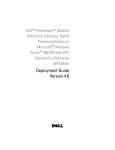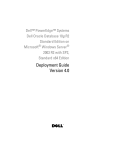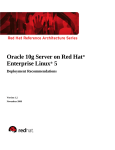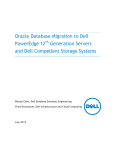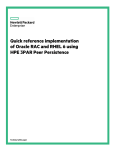Download Red Hat ENTERPRISE LINUX 4 - USING BINUTILS Installation guide
Transcript
Oracle® Database Release Notes 10g Release 2 (10.2) for Linux x86-64 B15666-11 February 2008 This document contains important information that was not included in the platform-specific or product-specific documentation for this release. This document supplements Oracle Database Readme and may be updated after it is released. To check for updates to this document and to view other Oracle documentation, refer to the Documentation section on the Oracle Technology Network (OTN) Web site: http://www.oracle.com/technology/documentation/ For additional information about this release, refer to the readme files located in the $ORACLE_HOME/relnotes directory. This document contains the following topics: ■ Certification Information ■ Unsupported Products ■ Preinstallation Requirements ■ Documentation Corrections and Additions ■ Installation, Configuration, and Upgrade Issues ■ Other Known Issues ■ Documentation Accessibility 1 Certification Information The latest certification information for Oracle Database 10g release 2 (10.2) is available on OracleMetaLink at: http://metalink.oracle.com 1.1 Supported Operating Systems Oracle Database 10g release 2 is supported on the following operating systems: ■ Oracle Enterprise Linux 4 ■ Oracle Enterprise Linux 5 ■ Red Hat Enterprise Linux 3 ■ Red Hat Enterprise Linux 4 ■ Red Hat Enterprise Linux 5 1 ■ SUSE Linux Enterprise Server 9 ■ SUSE Linux Enterprise Server 10 2 Unsupported Products The following products are not supported with Oracle Database 10g release 2 (10.2): ■ Grid Control Support Oracle Database 10g release 2 (10.2) can be managed as a target by Grid Control 10.1.0.4. However, Oracle Database 10g release 2 is not supported by Grid Control 10.1.0.4 as a repository. ■ Oracle Procedural Gateway for APPC ■ Oracle Procedural Gateway for WebSphere MQ ■ Oracle ODBC driver ■ Pro*COBOL 3 Preinstallation Requirements You must review the following sections before installing Oracle Database 10g release 2: When installing SUSE Linux Enterprise Server 10, if you choose Oracle Server Base and C/C++ Compiler and Tools options in the Software Selection and System Tasks window, then the following prerequisites are automatically available in the operating system. Note: ■ Install libaio Before Installing or Upgrading ■ Install oracleasm-support to use ASMLib ■ Install binutils on Oracle Enterprise Linux 4.0 and Red Hat Enterprise Linux 4.0 ■ Install libxm Before Installing Oracle Lite ■ Configuring Kernel Parameters ■ ■ Oracle HTTP Server on Oracle Enterprise Linux 4.0 and Red Hat Enterprise Linux 4.0 Oracle HTTP Server on Oracle Enterprise Linux 5.0 and Red Hat Enterprise Linux 5.0 3.1 Install libaio Before Installing or Upgrading Before upgrading to or installing Oracle Database 10g release 2, install the libaio package on Oracle Enterprise Linux 4.0 and Red Hat Enterprise Linux 4.0. 2 3.2 Install oracleasm-support to use ASMLib Install oracleasm-support package version 2.0.0.1 or higher to use ASMLib on Oracle Enterprise Linux 4.0, Red Hat Enterprise Linux 4.0 Advanced Server, or SUSE Linux Enterprise Server 9. At the time of this publication, the ASMLib user space tools and kernel module packages are not yet available for SUSE Linux Enterprise Server 10. 3.3 Install binutils on Oracle Enterprise Linux 4.0 and Red Hat Enterprise Linux 4.0 Before installing Oracle Database 10g release 2 on Oracle Enterprise Linux 4.0 and Red Hat Enterprise Linux 4.0 Update 1, install the following package: binutils-2.15.92.0.2-13.0.0.0.2.x86_64 This package can be downloaded from the following link: http://oss.oracle.com/projects/compat-oracle/dist/files/RedH at/binutils-2.15.92.0.2-13.0.0.0.2.x86_64.rpm This issue is tracked with Oracle bug 4619031. 3.4 Install libxm Before Installing Oracle Lite Before installing Oracle Lite, ensure that the following package is installed: libxml2-2.5.10-7.i386.rpm 3.5 Configuring Kernel Parameters After updating the values of kernel parameters in the /etc/sysctl.conf file, ensure that you either reboot the computer or run the sysctl -p command to make the changes of the /etc/sysctl.conf file available in the active kernel memory. On SUSE Linux Enterprise Server 9.0, ensure that you set the following kernel parameter: disable_cap_mlock = 1 On SUSE Linux Enterprise Server 10, ensure that you set the hugetlb_shm_group kernel parameter to the gid of the group used as the dba group. For example, on a system using a group named dba with the following entry in the /etc/group file: dba:!:104:oracle On SUSE Linux Enterprise Server 10, ensure that you set the hugetlb_shm_group kernel parameter to the GID of the group used as the dba group. For example, on a system using a group named dba with the dba:!:104:oracle entry in the /etc/group file, the hugetlb_shm_group kernel parameter should be set to the following value: hugetlb_shm_group = 104 3 3.6 Oracle HTTP Server on Oracle Enterprise Linux 4.0 and Red Hat Enterprise Linux 4.0 If you intend to use Oracle HTTP server, which is included in Companion CD of Oracle Database 10g Release 2 (10.2) Media pack, refer to the MetaLink note 317085.1 for more information on using Oracle HTTP server on Oracle Enterprise Linux 4.0 and Red Hat Enterprise Linux 4.0. 3.7 Oracle HTTP Server on Oracle Enterprise Linux 5.0 and Red Hat Enterprise Linux 5.0 If you intend to use Oracle HTTP server, which is included in Companion CD of Oracle Database 10g Release 2 (10.2) Media pack, refer to the MetaLink note 317085.1 for more information on using Oracle HTTP server on Oracle Enterprise Linux 5.0 and Red Hat Enterprise Linux 5.0. Legacy entry points required by this version of Apache (libdb.so.2) are moved to gdbm-1.8.0-26.2.1.i386. You must create a symlink using the following command: $ ln -s /usr/lib/libgdbm.so.2.0.0 /usr/lib/libdb.so.2 4 Documentation Corrections and Additions This section lists the following corrections to the installation guides for Linux x86-64. ■ In the "Software Requirements" section of quick installation guides and Chapter 2 of installation guides, the following (or later versions) should be the list of packages for Red Hat Enterprise Linux 3.0: make-3.79.1-17 compat-db 4.0.14-5.1 control-center-2.2.0.1-13 gcc-3.2.3-47 gcc-c++-3.2.3-47 gdb-6.1post-1.20040607.52 glibc-2.3.2-95.30 glibc-common-2.3.2-95.30 glibc-devel-2.3.2-95.30 glibc-devel-2.3.2-95.20 (32 bit) compat-db-4.0.14-5 compat-gcc-7.3-2.96.128 (32 bit) compat-gcc-c++-7.3-2.96.128 (32 bit) compat-libstdc++-7.3-2.96.128 (32 bit) compat-libstdc++-devel-7.3-2.96.128 (32 bit) gnome-libs-1.4.1.2.90-34.2 (32 bit) libstdc++-3.2.3-47 libstdc++-devel-3.2.3-47 openmotif-2.2.3-3.RHEL3 sysstat-5.0.5-5.rhel3 setarch-1.3-1 libaio-0.3.96-3 libaio-devel-0.3.96-3 ■ The following (or later versions) should be the list of packages for Oracle Enterprise Linux 4.0 and Red Hat Enterprise Linux 4.0: 4 binutils-2.15.92.0.2-10.EL4 compat-db-4.1.25-9 compat-libstdc++-33-3.2.3-47.3 compat-libstdc++-33-3.2.3-47.3(i386) compat-libstdc++-296.i386 control-center-2.8.0-12 gcc-3.4.3-22.1 gcc-c++-3.4.3-22.1 glibc-2.3.4-2 glibc-2.3.4-2(i386) glibc-common-2.3.4-2 glibc-devel-2.3.4-2 glibc-devel-2.3.4-2(i386) gnome-libs-1.4.1.2.90-44.1 libaio-0.3.96-3 libgcc-3.4.3-9.EL4 libstdc++-3.4.3-9.EL4 libstdc++-devel-3.4.3-9.EL4 make-3.80-5 pdksh-5.2.14-30 sysstat-5.0.5-1 xorg-x11-deprecated-libs-6.8.1-23.EL ■ The following (or later version) should be the list of packages for Oracle Enterprise Linux 5.0 and Red Hat Enterprise Linux 5.0: binutils-2.17.50.0.6-2.el5 compat-gcc-34-3.4.6-4 compat-gcc-34-c++-3.4.6-4 compat-libstdc++-33-3.2.3-61 compat-libstdc++-33-3.2.3-61(i386) control-center-2.16.0-14.el5 gcc-4.1.1-52.el5 gcc-c++-4.1.1-52.el5 gdbm-1.8.0-26.2.1 glibc-2.5-12 glibc-common-2.5-12 glibc-devel-2.5-12 glibc-devel-2.5-12(i386) libgcc-4.1.1-52.el5(i386) libgcc-4.1.1-52.el5(x86_64) libgnome-2.16.0-6.el5 libstdc++-devel-3.4.3-22.1 libXp-1.0.0-8.i386 make-3.81-1.1 sysstat-7.0.0-3.el5.x86_64.rpm util-linux-2.13-0.44.e15.x86_64 ■ In Oracle Database Oracle Clusterware and Oracle Real Application Clusters Installation Guide, Chapter 2, "Preinstallation," in the section "Oracle Clusterware Home Directory," it incorrectly lists the path /u01/app/oracle/product/crs as a possible Oracle Clusterware home (or CRS home) path. This is incorrect. A default Oracle base path is /u01/app/oracle, and the Oracle Clusterware home must never be a subdirectory of the Oracle base directory. A possible CRS home directory is in a path outside of the Oracle base directory. for example, if the Oracle base directory is u01/app/oracle, then the CRS home can be an option similar to one of the following: 5 u01/crs/ /u01/crs/oracle/product/10/crs /crs/home This issue is tracked with Oracle bug 5843155. ■ The following text of the section 2.6.1, "IP Address Requirements," in Chapter 2, "Pre-Installation Tasks," of Oracle Database Oracle Clusterware and Oracle Real Application Clusters Installation Guide states that the virtual IP address (VIP) should respond to a ping command: During installation, OUI uses the ping command to ensure that the VIP is reachable. The preceding statement is incorrect. Before installation, the VIP address should be configured in DHCP or /etc/hosts, or both, but it must not be assigned to a server that can respond to a ping command. This issue is tracked with Oracle bug 6017001. ■ ■ Appendix H, "Database Limits" of Oracle Database Administrator's Reference for UNIX-Based Operating Systems states the incorrct maximum value (63) for the MAXINSTANCES variable. The correct maximum limit for the variable is 1055. In the "NFS Mount Options" section of Appendix C, "Using NAS Devices" in Oracle Database Installation Guide 10g Release 2 (10.2) for Linux x86-64 the table should also contain the following entry: Option Description directio Disable attribute caching. Note: If the systems supports direcio, use this option instead of noac to reliably disable caching. 5 Installation, Configuration, and Upgrade Issues Review the following sections for information about issues that affect Oracle Database installation, configuration, and upgrade: ■ Latest Upgrade Information ■ Upgrading Oracle Real Application Clusters Release 9.2 ■ Oracle Universal Installer Operating System Prerequisite Checks ■ Installing Oracle Cluster Ready Services ■ Installing Enterprise Security Manager ■ Upgrading Oracle Clusterware 10.1.x to Oracle Clusterware 10.2 ■ extjob Executable Required Directory Permissions ■ Modifying a Virtual IP Address Node Application ■ Raw Devices on Oracle Enterprise Linux and Red Hat Enterprise Linux ■ Database Migration 6 5.1 Latest Upgrade Information For late-breaking updates and best practices about preupgrade, post-upgrade, compatibility, and interoperability discussions, refer to Note 466181.1 on OracleMetalink (https://metalink.oracle.com/) that links to "The Upgrade Companion" Web site. 5.2 Upgrading Oracle Real Application Clusters Release 9.2 If you are upgrading a 9.2 RAC environment to Oracle Database 10g release 2 on Red Hat Linux 3.0, then you must apply a patch to GLIBC before proceeding with the Oracle Clusterware installation. Follow the instructions documented in OracleMetaLink note 284535.1. This issue is tracked with Oracle bug 3006854. 5.3 Oracle Universal Installer Operating System Prerequisite Checks If you are installing Oracle Database 10g on Oracle Enterprise linux 5.0, Red Hat Enterprise Linux 5.0, or SUSE Linux Enterprise Server 10, the current version of Oracle Universal Installer does not recognized these operating systems as supported operating systems and does not perform the installation. Workaround #1 (recommended): Run the Oracle Universal Installer using the ignoreSysPrereqs flag which causes the installer to skip the operating system check and continue with the installation: ./runinstaller -ignoreSysPrereqs As a side effect, the installer also skips other checks during the installation. Workaround #2: On Oracle Enterprise Linux 5.0 and Red Hat Enterprise Linux 5.0, the installation passes the operating system prerequisite checks if you change each 5 to 4 in the /etc/redhat-release file. Ensure that you replace the original values in the /etc/redhat-release file after the Oracle installation is complete. Original Value Changed Value Enterprise Linux Enterprise Linux server release 5 Enterprise Release Enterprise Linux server release 4 (On Oracle Enterprise Linux 5.0) Red Hat Enterprise Linux server release 5 Red Hat Enterprise Linux server release 4 (On Red Hat Enterprise Linux 5.0) On SUSE Linux Enterprise Server 10, the installation will pass the operating system prerequisite checks if you change each 10 to 9 in the /etc/SuSE-release file. Ensure that you replace the original values in the /etc/SuSE-release file after the Oracle installation is complete. Original Value Changed Value SUSE Linux Enterprise Server 10 (x86_64) SUSE Linux Enterprise Server 9 (x86_64) 7 Original Value Changed Value VERSION = 10 VERSION = 9 This workaround causes the installer to consider the system to be running earlier version of the operating system and the operating system check passes. The changes to the release file should be reverted after the installation of all Oracle software is complete. The changes to the release file could impact the ability of other tools to be properly installed on the operating system. 5.4 Installing Oracle Cluster Ready Services Near the end of the installation of Oracle Cluster Ready Services, Oracle Universal Installer prompts for the $CRS_HOME/root.sh script to be run on all of the nodes in the cluster. When the root.sh script is run on the last node in the cluster, the script calls the VIPCA utility, which fails on Oracle Enterprise Linux 5.0, Red Hat Enterprise Linux 5.0, and SUSE Linux Enterprise Linux 10. Refer to the "SRVCTL and VIPCA Utilities Set the LD_ASSUME_KERNEL Parameter" section for more details. Workaround: Before running the root.sh script on the last node in the cluster, alter the $CRS_HOME/bin/vipca script commenting out lines 119 through 123: # # # # # arch=’uname -m’ if [ "$arch" = "i686" -o "$arch" = "ia64" -o "$arch" = "x86_64" ] then LD_ASSUME_KERNEL=2.4.19 export LD_ASSUME_KERNEL fi With the lines commented out, root.sh should be able to call VIPCA successfully. Ensure that you do not comment out line 118, which sets the arch variable as that is needed by the root.sh script. 5.5 Installing Enterprise Security Manager To install Oracle Security Manager, install Oracle Client and then select the Administrator installation type. 5.6 Upgrading Oracle Clusterware 10.1.x to Oracle Clusterware 10.2 When upgrading from 10.1.x to 10.2, Oracle Clusterware will not start if the host name directory under the /etc/oracle/scls_scr directory includes the domain name. The following error message is displayed when you run the rootupgrade.sh script. A file or directory in the path name does not exist. /etc/init.cssd[509]: /etc/oracle/scls_scr/host_name/root/cssrun: 0403-005 Cannot create the specified file. Workaround: Move the /etc/oracle/scls_scr/hostname.domain_name directory to /etc/oracle/scls_scr/hostname and rerun the rootupgrade.sh script. This issue is tracked with Oracle bug 4472284. 8 5.7 extjob Executable Required Directory Permissions To enable the extjob executable to locate required libraries, the $ORACLE_HOME/lib directory and all of its parent directories must have execute permissions for group and other. 5.8 Modifying a Virtual IP Address Node Application Use the srvctl modify nodeapps command to modify the name, IP address, or netmask of an existing virtual IP address (VIP) resource. Use the -A argument to include the existing interfaces for the VIP: srvctl modify nodeapps -n mynode1 -A 100.200.300.40/255.255.255.0/eth0 This issue is tracked with Oracle bug 4500688. 5.9 Raw Devices on Oracle Enterprise Linux and Red Hat Enterprise Linux Verify that an appropriate raw devices utility (util-linux) rpm is installed for the update of the operating systems. For example, on Oracle Enterprise Linux 4.0 and Red Hat Enterprise Linux 4.0 (update 5), util-linux-2.12a-16.EL4.23.x86_64 or later rpm should be installed. On Oracle Enterprise Linux 5.0 and Red Hat Enterprise Linux 5.0, util-linux-2.13-0.44.EL5.x86_64 or later rpm should be installed. When you restart an Oracle Enterprise Linux 4.0, Oracle Enterprise Linux 5.0, Red Hat Enterprise Linux 4.0, or Red Hat Enterprise Linux 5.0 system, raw devices revert to their original owners and permissions by default. If you are using raw devices with this operating system for your Oracle files, for example, for ASM storage or Oracle Clusterware files, you need to override this default behavior. To do this, add an entry to the /etc/rc.d/rc.local file for each raw device containing the chmod and chown commands required to reset them to the required values. As an example, here are sample entries in a /etc/rc.d/rc.local file that control the restart behavior of raw devices for two ASM disk files (/dev/raw/raw6 and /dev/raw/raw7), two Oracle Cluster Registry files (/dev/raw/raw1 and /dev/raw/raw2), and three Oracle Clusterware voting disks (/dev/raw/raw3, /dev/raw/raw4, and /dev/raw/raw5): # ASM chown oracle:dba /dev/raw/raw6 chown oracle:dba /dev/raw/raw7 chmod 660 /dev/raw/raw6 chmod 660 /dev/raw/raw7 # OCR chown root:oinstall /dev/raw/raw1 chown root:oinstall /dev/raw/raw2 chmod 660 /dev/raw/raw1 chmod 660 /dev/raw/raw2 # Voting Disks chown oracle:oinstall /dev/raw/raw3 chown oracle:oinstall /dev/raw/raw4 chown oracle:oinstall /dev/raw/raw5 chmod 644 /dev/raw/raw3 chmod 644 /dev/raw/raw4 chmod 644 /dev/raw/raw5 9 5.10 Database Migration Review the following sections if you want to migrate Oracle Database 10g release 2 database from Linux x86 to Linux x86-64: ■ Migrating Single Instance Database from Linux x86 to Linux x86-64 ■ Migrating Oracle RAC Database from Linux x86 to Linux x86-64 5.10.1 Migrating Single Instance Database from Linux x86 to Linux x86-64 To migrate Oracle 10g release 2 single instance database from Linux x86 to Linux x86-64, complete the following procedure: 1. To protect the existing database 10g release 2 against any failures during the migration, ensure that you take a complete backup of the database on Linux x86-64 system. 2. To create a control file that helps file after the migration, run the following SQL command from the SQL prompt on the Linux x86 system: SQL> ALTER DATABASE BACKUP CONTROLFILE TO TRACE; This command saves the control file information to a trace file in the UDUMP directory. The control file information is similar to the following where ia32lnx_path is the location of the Linux x86 Oracle home: CREATE CONTROLFILE REUSE DATABASE "SAMPLE" NORESETLOGS NOARCHIVELOG MAXLOGFILES 32 MAXLOGMEMBERS 2 MAXDATAFILES 32 MAXINSTANCES 1 MAXLOGHISTORY 112 LOGFILE GROUP 1 '/ia32lnx_path/oradata/eegp22/redo01.log' 25M, GROUP 2 '/ia32lnx_path/oradata/eegp22/redo02.log' 25M DATAFILE '/ia32lnx_path/oradata/eegp22/system01.dbf', '/ia32lnx_path/oradata/eegp22/sysaux01.dbf', '/ia32lnx_path/oradata/eegp22/users01.dbf', '/ia32lnx_path/oradata/eegp22/undotbs01.dbf' CHARACTER SET WE8DEC; 3. Perform a clean Oracle database shutdown. SQL> SHUTDOWN IMMEDIATE 4. Copy the database files to the Linux x86-64 system. 5. In a new Oracle home, install the Oracle 10g release 2 software for Linux x86-64. 6. Copy the Oracle initialization parameter file (initsid.ora) to the new Oracle home. Change any Oracle home path references to use the new Oracle home path on the Linux x86-64 system. 7. Start up the database using SQL commands similar to the following example where lnx_x86-64_path is the location of the Linux x86-64 Oracle home: SQL> STARTUP NOMOUNT; CREATE CONTROLFILE REUSE DATABASE "EEGP102" NORESETLOGS MAXLOGFILES 32 MAXLOGMEMBERS 2 MAXDATAFILES 32 10 MAXINSTANCES 1 MAXLOGHISTORY 112 LOGFILE GROUP 1 '/lnx_x86-64_path/oradata/eegp22/redo01.log'size 25M, GROUP 2 '/lnx_x86-64_path/oradata/eegp22/redo02.log'size 25M DATAFILE '/lnx_x86-64_path/oradata/eegp22/system01.dbf', '/lnx_x86-64_path/eegp22/sysaux01.dbf', '/lnx_x86-64_path/eegp22/users01.dbf', '/lnx_x86-64_path/eegp22/undotbs01.dbf' CHARACTER SET WE8DEC ALTER DATABASE OPEN ; Note: In the preceding example, the path value changes as per the system. 8. To change the word size of the release, run the following commands: SQL> STARTUP UPGRADE; SQL> @$ORACLE_HOME/rdbms/admin/utlirp.sql 9. Run the utlrp.sql script to recompile all PL/SQL packages now instead of when the packages are accessed for the first time. This step is optional but recommended. SQL> @$ORACLE_HOME/rdbms/admin/utlrp.sql 10. Perform a clean shutdown of the database. SQL> SHUTDOWN IMMEDIATE 11. Take a complete backup of the database. See Also: ■ Oracle Database Backup and Recovery Basics ■ Oracle Database Backup and Recovery Advanced User's Guide ■ Oracle Database Backup and Recovery Reference ■ Oracle Database Backup and Recovery Quick Start Guide 5.10.2 Migrating Oracle RAC Database from Linux x86 to Linux x86-64 To migrate Oracle RAC 10g release 2 from Linux x86 to Linux x86-64, complete the following procedure: 1. Complete steps 1 to 5 of the "Migrating Single Instance Database from Linux x86 to Linux x86-64" section. 2. Use the following command to ensure that gsd is running: $ ps -elf | grep gsd 3. Use the $ORACLE_HOME/bin/srvctl utility to add the database name and the cluster node names in Linux x86-64. To create a database, use a command similar to the following command: $ srvctl add database -d 10gdb -o ORACLE_HOME -m us.oracle.com \-s /dev/raw/raw2 11 To create an instance, use a command similar to the following command: $ srvctl add instance -d 10gdb -i 10gdb1 -n pl-adc.amd15 4. Set the ORACLE_SID environment variable for one of the database instances in the environment. For the Bash or Korn shell: $ ORACLE_SID=10gdb1; export ORACLE_SID For the C shell: % setenv ORACLE_SID 10gdb1 5. Export the server parameter file (SPFILE) to a text initialization parameter file as follows: SQL> CREATE PFILE = '$ORACLE_HOME/dbs/init10gdb1.ora' FROM SPFILE = '/dev/raw/raw2'; 6. Edit the text initialization parameter file to update path names to point to the Linux x86-64 Oracle home directory along with any other required changes. Then re-create the SPFILE as follows: SQL> CREATE SPFILE = '/dev/raw/raw2' FROM PFILE = '$ORACLE_HOME/dbs/init10gdb1.ora'; Note: If the cluster database does not start in EXCLIUSIVE MODE, mark all the entries with cluster-database as comments in the SPFILE. 7. Directories listed in the SPFILE must exist before you start the database. Create these directories, ensuring that they have write permissions for the oracle user and dba groups. 8. Add a listener name for the database that listens on all cluster nodes to the $ORACLE_HOME/network/admin/tnsnames.ora file. Also add an entry for each instance. The following is an example of the entries: LISTENERS_10gdb.US.ORACLE.COM = (ADDRESS_LIST = (ADDRESS = (PROTOCOL = TCP) (HOST (ADDRESS = (PROTOCOL = TCP) (HOST LISTENERS_10gdb1.US.ORACLE.COM = (ADDRESS = (PROTOCOL = TCP) (HOST LISTENERS_10gdb2.US.ORACLE.COM = (ADDRESS = (PROTOCOL = TCP) (HOST 9. = server1-vip) (PORT = 1521) = server2-vip) (PORT = 1521) = server1-vip) (PORT = 1521) = server2-vip) (PORT = 1521) Create the password file using the orapwd utility. Use a command similar to the following: $ orapwd file=$ORACLE_HOME/dbs/orapwd10gdb1 entries=10 password=manager 10. Start the database without mounting it, using SQL commands similar to the following where lnx_x86-64_path is the location of the Linux x86-64 Oracle home: SQL> STARTUP NOMOUNT; CREATE CONTROLFILE REUSE DATABASE "SAMPLE" NORESETLOGS MAXLOGFILES 32 12 MAXLOGMEMBERS 2 MAXDATAFILES 32 MAXINSTANCES 1 MAXLOGHISTORY 112 LOGFILE GROUP 1 '/lnx_x86-64_path/oracle/dbs/t_log1.dbf' size 25M GROUP 2 '/lnx_x86-64_path/oracle/dbs/t_log2.dbf' size 25M DATAFILE '/lnx_x86-64_path/oracle/dbs/t_db1.dbf' CHARACTER SET WE8DEC ALTER DATABASE OPEN 11. Shut down the database. SQL> SHUTDOWN IMMEDIATE 12. Before changing the word size of your release, you must edit the initialization parameter file (pfile) by adding the following line: _system_trig_enabled=false 13. Use the following command to start the database: SQL> STARTUP PFILE = '$ORACLE_HOME/dbs/init-10gdb1.ora' 14. Check the amount of free space in the SYSTEM tablespace. Ensure there is enough room for SYSTEM tablespace to increase its size by 50%. SQL> SELECT SUM (df.bytes) AS total, SUM (fs.bytes) AS free, (SUM (fs,bytes)/SUM(df.bytes) * 100) AS percent_free FROM dba_data_files df, DBA_FREE_SPACE fs WHERE df.tablespace_name = 'SYSTEM' AND df.tablespace_name = fs.tablespace_name GROUP BY df.tablespace_name If you get a percent_free value less than 33%, then you must add a new raw device data file to SYSTEM tablespace, for example: SQL> ALTER TABLESPACE SYSTEM ADD DATAFILE '/dev/raw/raw108' SIZE 200M; 15. Use the following commands to restart the database in upgrade mode: SQL> SHUTDOWN IMMEDIATE; SQL> STARTUP UPGRADE 16. To change the word size of your release, enter the following command: SQL> @$ORACLE_HOME/rdbms/admin/utlirp.sql 17. Run the utlrp.sql script to recompile all PL/SQL packages now instead of when the packages are accessed for the first time. This step is optional but recommended. SQL> @$ORACLE_HOME/rdbms/admin/utlrp.sql 13 Note: You need to shutdown the database and start it in upgrade mode. 18. Edit the text initialization parameter file to remove the following line: _system_trig_enabled=false 19. To restart the database, use the following command: ./srvctl start database -d 10gdb -o pfile=$USR_ORA_PFILE Ensure that the USR_ORA_PFILE variable is set to the location of pfile. Alternately, you can specify the complete path of pfile in the command. 20. To create instances on the other cluster nodes, complete the following steps: a. Copy the $ORACLE_HOME/network/admin/tnsnames.ora file to the same location on each node. b. Create the dump directories listed in the initialization parameter file (pfile) in the Oracle home directory. c. Copy the initialization parameter file (pfile) from the original node to the $ORACLE_HOME/dbs directory, changing its name to reflect the instance name on the current node. d. Create a password file in the $ORACLE_HOME/dbs directory, ensuring its name includes the instance name for the node. e. Start up the instance. 6 Other Known Issues The following sections contain information about issues related to Oracle Database 10g and associated products: ■ Building Pro*C Applications if PostgreSQL is Installed ■ Encoding Information Not Present in Translated Help Files ■ Oracle Clusterware Files Issues ■ Cluster Verification Utility ■ Removing Metrics for Wait Classes Removes Them Permanently ■ Support for 64-Bit JDBC ■ Patch for Oracle Clusterware Configuration with Voting Disk on Network Attached Storage ■ SRVCTL and VIPCA Utilities Set the LD_ASSUME_KERNEL Parameter ■ Mapping of 127.0.0.2 to the Local Hostname ■ ■ Error While Loading Shared Library When selinux is Enabled on Oracle Enterprise Linux 5.0 and Red Hat Enterprise Linux 5.0 MAX_IDLE_BLOCKER_TIME Does Not Work in Oracle RAC Environment 14 6.1 Building Pro*C Applications if PostgreSQL is Installed If the postgresql-devel package is installed on the system, then you must add the following directory to the beginning of the sys_include parameter in the $ORACLE_HOME/precomp/admin/pcscfg.cfg file before building Pro*C applications: $ORACLE_HOME/precomp/public If you do not make this change, then you may encounter errors similar to the following when linking the applications: /tmp/ccbXd7v6.o(.text+0xc0): In function ’drop_tables’: : undefined reference to ’sqlca’ This issue is tracked with Oracle bug 3933309. 6.2 Encoding Information Not Present in Translated Help Files If the system uses a European language, you might see corrupted characters in Table of Contents of database tools, such as Database Configuration Assistant. This issue is tracked with Oracle bug 3957096. Workaround: If the system uses a European language, do not use the .UTF-8 locale. For example, if the system uses German, set the LANG and LC_ALL environment variables to de_DE instead of de_DE.UTF-8. 6.3 Oracle Clusterware Files Issues The following note applies if you are using Oracle Enterprise Linux 4.0, Oracle Enterprise Linux 5.0, Red Hat Enterprise Linux 4.0, Red Hat Enterprise Linux 5.0, or SUSE Linux Enterprise Server 10 and using raw devices to store the Oracle Cluster Registry (OCR) and the voting disk for Oracle Clusterware, or using raw devices for Automatic Storage Management (ASM) database files. For each raw device used for the purposes listed, you must add two entries in the /etc/rc.d/rc.local file on Oracle Enterprise Linux 4.0, Oracle Enterprise Linux 5.0, Red Hat Enterprise Linux 4.0, and Red Hat Enterprise Linux 5.0, or the /etc/init.d/after.local file on SUSE Linux Enterprise Server 10 after running the root.sh script following the installation of Oracle Clusterware. For each OCR file, the entries should look as follows, where oinstall is the Oracle install group and /dev/raw/rawn is an individual device file: chown root:oinstall /dev/raw/rawn chmod 660 /dev/raw/rawnmar For each voting disk file, the entries should look as follows, where oracle is the Oracle user, oinstall is the Oracle install group, and /dev/raw/rawn is an individual device file: chown oracle:oinstall /dev/raw/rawn chmod 644 /dev/raw/rawnmar For each ASM file, the entries should look as follows, where oracle is the Oracle user, oinstall is the Oracle install group, and /dev/raw/rawn is an individual device file: chown oracle:oinstall /dev/raw/rawn chmod 660 /dev/raw/rawnmar 15 6.4 Cluster Verification Utility This section lists the issues with Cluster Verification Utility on Oracle Enterprise Linux 4.0, Oracle Enterprise Linux 5.0, Red Hat Enterprise Linux 4.0, Red Hat Enterprise Linux 5.0, and SUSE Linux Enterprise Server 9 and 10: ■ ■ Cluster Verification Utility (CVU) does not support shared checks for raw disks used for Oracle Cluster File System version 2 on Oracle Enterprise Linux 4.0, Oracle Enterprise Linux 5.0, Red Hat Enterprise Linux 4.0, Red Hat Enterprise Linux 5.0, and SUSE Linux Enterprise Server 9 and 10. Cluster Verification Utility (CVU) does not detect SMP-Kernel rpms for the hosts and displays the "Kernel check failed" message. In verbose mode, the status for kernel is displayed as "missing". This issue is tracked with Oracle bug 4685951. ■ The preinstallation stage verification checks for Oracle Clusterware and Oracle Real Applications Clusters and reports missing packages. Ignore the following missing packages and continue with the installation: compat-gcc-7.3-2.96.128 compat-gcc-c++-7.3-2.96.128 compat-libstdc++-7.3-2.96.128 compat-libstdc++-devel-7.3-2.96.128 6.5 Removing Metrics for Wait Classes Removes Them Permanently Do not remove the key values for the wait class metrics. Doing so removes them permanently and currently there is no easy way to recover them. This issue is tracked with Oracle bug 4602952. 6.6 Support for 64-Bit JDBC For Oracle Database 10g release 2 on Linux x86-64, 64-bit JDBC (using JDK 5) is supported. 6.7 Patch for Oracle Clusterware Configuration with Voting Disk on Network Attached Storage To resolve Oracle Clusterware configuration issue when voting disk is on Network Attached Storage, you need to apply the patch tracked through Oracle bug 4697432. 6.8 SRVCTL and VIPCA Utilities Set the LD_ASSUME_KERNEL Parameter The SRVCTL and VIPCA utilities shipped with Oracle Database 10g release 2 and Oracle Clusterware software set the environmental variable LD_ASSUME_KERNEL. On SUSE Linux Enterprise Server 10, because the older Linux threads API has been removed from GLIBC, setting this parameter causes the SRVCTL and VIPCA utilities to exit with the following error: /opt/oracle/crs/jdk/jre/bin/java: error while loading shared libraries: libpthread.so.0: cannot open shared object file: No such file or directory 16 Workaround: Comment out the lines that set the LD_ASSUME_KERNEL variable from the VIPCA and SRVCTL utilities. For the VIPCA utility alter the $CRS_HOME/bin/vipca script commenting out lines 119 through 123 as follows: # # # # # arch=’uname -m’ if [ "$arch" = "i686" -o "$arch" = "ia64" -o "$arch" = "x86_64" ] then LD_ASSUME_KERNEL=2.4.19 export LD_ASSUME_KERNEL fi With the lines commented out, root.sh should be able to call VIPCA successfully. Ensure that you do not to comment out line 118 which sets the arch variable as that is needed by the script. For the SRVCTL utility alter the $CRS_HOME/bin/srvctl and the $ORACLE_HOME/bin/srvctl scripts commenting out lines 173 and 174 as follows: #Remove this workaround when the bug 3937317 is fixed #LD_ASSUME_KERNEL=2.4.19 #export LD_ASSUME_KERNEL 6.9 Mapping of 127.0.0.2 to the Local Hostname By default, the hostname of a machine is mapped to the IP address 127.0.0.2 through an entry in the /etc/hosts similar to the following on SUSE Linux Enterprise Server 10: 127.0.0.2 test test.example.com YaST does this to provide compatibility with earlier versions of the applications that had problems running on desktops with dynamically assigned hostnames from DHCP. This mapping may cause certain Oracle networking libraries to encounter errors when they attempt to resolve the hostname of the machine. To avoid these problems, the entry should be removed from the /etc/hosts file. Note that several network related YaST utilities may add this entry back to the file. 6.10 Error While Loading Shared Library When selinux is Enabled on Oracle Enterprise Linux 5.0 and Red Hat Enterprise Linux 5.0 Oracle Call Interface (OCI) program calls fail with selinux enabled on Oracle Enterprise Linux 5.0 and Red Hat Enterprise Linux 5.0. Workaround: Disable selinux on the system. This issue is tracked with Oracle bug 6079461. 6.11 MAX_IDLE_BLOCKER_TIME Does Not Work in Oracle RAC Environment Setting a value for MAX_IDLE_BLOCKER_TIME feature of Resource manager does not work as expected in Oracle RAC environment. 17 Workaround: Set a value for MAX_IDLE_TIME instead of setting a value for MAX_IDLE_BLOCKER_TIME. This issue is tracked with Oracle bug 6114355. 7 Documentation Accessibility Our goal is to make Oracle products, services, and supporting documentation accessible, with good usability, to the disabled community. To that end, our documentation includes features that make information available to users of assistive technology. This documentation is available in HTML format, and contains markup to facilitate access by the disabled community. Accessibility standards will continue to evolve over time, and Oracle is actively engaged with other market-leading technology vendors to address technical obstacles so that our documentation can be accessible to all of our customers. For more information, visit the Oracle Accessibility Program Web site at http://www.oracle.com/accessibility/. Accessibility of Code Examples in Documentation Screen readers may not always correctly read the code examples in this document. The conventions for writing code require that closing braces should appear on an otherwise empty line; however, some screen readers may not always read a line of text that consists solely of a bracket or brace. Accessibility of Links to External Web Sites in Documentation This documentation may contain links to Web sites of other companies or organizations that Oracle does not own or control. Oracle neither evaluates nor makes any representations regarding the accessibility of these Web sites. TTY Access to Oracle Support Services Oracle provides dedicated Text Telephone (TTY) access to Oracle Support Services within the United States of America 24 hours a day, seven days a week. For TTY support, call 800.446.2398. Oracle Database Release Notes, 10g Release 2 (10.2) for Linux x86-64 B15666-11 Copyright © 2006, 2008, Oracle. All rights reserved. The Programs (which include both the software and documentation) contain proprietary information; they are provided under a license agreement containing restrictions on use and disclosure and are also protected by copyright, patent, and other intellectual and industrial property laws. Reverse engineering, disassembly, or decompilation of the Programs, except to the extent required to obtain interoperability with other independently created software or as specified by law, is prohibited. The information contained in this document is subject to change without notice. If you find any problems in the documentation, please report them to us in writing. This document is not warranted to be error-free. Except as may be expressly permitted in your license agreement for these Programs, no part of these Programs may be reproduced or transmitted in any form or by any means, electronic or mechanical, for any purpose. If the Programs are delivered to the United States Government or anyone licensing or using the Programs on behalf of the United States Government, the following notice is applicable: U.S. GOVERNMENT RIGHTS Programs, software, databases, and related documentation and technical data delivered to U.S. Government customers are "commercial computer software" or "commercial technical data" pursuant to the applicable Federal Acquisition Regulation and agency-specific supplemental regulations. As such, use, duplication, disclosure, modification, and adaptation of the Programs, including documentation and technical data, shall be subject to the licensing restrictions set forth in the applicable Oracle license agreement, and, to the extent applicable, the additional rights set forth in FAR 52.227-19, Commercial Computer Software—Restricted Rights (June 1987). Oracle USA, Inc., 500 Oracle Parkway, Redwood City, CA 94065. The Programs are not intended for use in any nuclear, aviation, mass transit, medical, or other inherently dangerous applications. It shall be the licensee's responsibility to take all appropriate fail-safe, backup, redundancy and other measures to ensure the safe use of such applications if the Programs are used for such purposes, and we disclaim liability for any damages caused by such use of the Programs. Oracle, JD Edwards, PeopleSoft, and Siebel are registered trademarks of Oracle Corporation and/or its affiliates. Other names may be trademarks of their respective owners. The Programs may provide links to Web sites and access to content, products, and services from third parties. Oracle is not responsible for the availability of, or any content provided on, third-party Web sites. You bear all risks associated with the use of such content. If you choose to purchase any products or services from a third party, the relationship is directly between you and the third party. Oracle is not responsible for: (a) the quality of third-party products or services; or (b) fulfilling any of the terms of the agreement with the third party, 18 including delivery of products or services and warranty obligations related to purchased products or services. Oracle is not responsible for any loss or damage of any sort that you may incur from dealing with any third party. 19 20




















